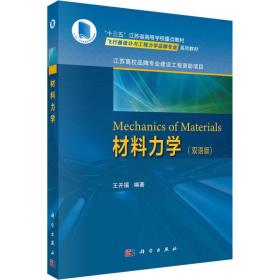
材料力学(双语版) 大中专理科科技综合
大中专理科科技综合 新华书店全新正版书籍
¥ 58.6 7.4折 ¥ 79 全新
库存4件
河北保定
认证卖家担保交易快速发货售后保障
作者作者
出版社科学出版社
ISBN9787030589361
出版时间2018-09
版次1
装帧平装
开本其他
页数284页
字数480千字
定价79元
货号xhwx_1201795801
上书时间2021-12-04
- 最新上架
商品详情
- 品相描述:全新
- 正版特价新书
- 商品描述
-
目录:
章 材料力学基础
1.1 外力
1.2 内力
1.3 应力
1.4 应变
1.5 胡克定律
1.6 低碳钢拉伸能
1.7 无明显屈服点塑材料的应力应变曲线
1.8 塑材料和脆材料
1.9 材料压缩能
题
第2章 轴向拉伸与压缩
2.1 轴力
2.2 横截面正应力
2.3 斜截面正应力和剪应力
2.4 线应变
2.5 拉压变形
2.6 静不定拉压杆
2.7 拉压杆设计
题
第3章 扭转
3.1 扭矩
3.2 剪切胡克定律
3.3 横截面剪应力
3.4 斜截面正应力和剪应力
3.5 扭转角
3.6 静不定轴
3.7 扭转轴设计
题
第4章 弯曲内力
4.1 剪力图和弯矩图
4.2 分布载荷、剪力和弯矩之间的关系
4.3 集中载荷、剪力和弯矩之间的关系
题
第5章 弯曲应力
5.1 纯弯曲横截面正应力
5.2 横力弯曲横截面正应力和剪应力
5.3 弯曲梁设计
题
第6章 弯曲变形
6.1 积分
6.2 叠加
6.3 静不定梁
题
第7章 应力分析与强度理论
7.1 应力变换
7.2 主应力
7.3 优选剪应力
7.4 压力容器
7.5 广义胡克定律
7.6 强度理论
题
第8章 组合载荷
8.1 偏心拉压杆
8.2 横力弯曲工字梁
8.3 拉压弯曲梁
8.4 弯曲扭转轴
题
第9章 压杆稳定
9.1 两端铰支细长压杆临界载荷
9.2 其他支撑细长压杆临界载荷
9.3 细长压杆临界应力
9.4 中长压杆临界应力
9.5 压杆设计
题
0章 非对称弯曲
10.1 非对称纯弯曲
10.2 非对称横力弯曲
题
1章 能量方
11.1 外功
11.2 应变能密度
11.3 应变能
11.4 功能
11.5 互等定理
11.6 卡氏定理
11.7 虚功
11.8 单位载荷
11.9 能量方应用
题
2章 冲击载荷
12.1 垂直冲击
12.2 水冲击
题
3章 静不定结构
13.1 静不定
13.2 力分析静不定结构
13.3 力分析对称静不定结构
题
附录ⅰ截面质
ⅰ.1 静矩
ⅰ.2 惯矩与极惯矩
ⅰ.3 惯半径与极惯半径
ⅰ.4 惯积
ⅰ.5 行移轴定理
ⅰ.6 常用截面几何质
附录ⅱ型钢
ⅱ.1 工字钢
ⅱ.2 槽钢
ⅱ.3 等边角钢
ⅱ.4 不等边角钢
附录ⅲ挠度曲线
参文献
内容简介:
材料力学(双语版)是材料力学双语教材,分别由英文和中文独立编写。该书主要内容包括材料力学基础、轴向拉伸与压缩、扭转、弯曲内力、弯曲应力、弯曲变形、应力分析与强度理论、组合载荷、压杆稳定、非对称弯曲、能量方、冲击载荷和静不定结构等。材料力学(双语版)可作为航空航天工程、机械工程和土木工程等工科专业本科生的材料力学双语教材。
精彩内容:
chapter 1 mechanics of materials fundamentals
in theoretical mechanics, bodies are assumed to be perfectly rigid.the deformations of bodies are important, however, as far as the resistance of the structures and machines to failure is concerned.therefore, the bodies in mechanics of materials will no longer be assumed to be perfectly rigid as considered in theoretical mechanics.
mechanics of materials studies the ability of structures and machines to resist failure, and mainly involves the following tasks: ① strength, i.e., the ability of members to support a specified load without experiencing excessive stresses; ② rigidity, i.e., the ability of members to support a specified load without undergoing unacceptable deformations; ③ stability, i.e., the ability of members to support a specified aal pressive load without causing a sudden lateral deflection.
any material dealt with in mechanics of materials is assumed to be: ① continuous, i.e., the material consists of a continuous distribution of matter without voids; ② homogeneous, i.e., the material sesses the same mechanical properties at all points in the matter; ③ isotropic, i.e., the material has the same mechanical properties in all directions at any one point of the matter.
the strength and rigidity of a material depend on its abilities to support a specified load without experiencing both excessive stresses and unacceptable deformations.these abilities are inherent in the material itself and must be determined by experimental methods.one of the most important tests to determine the mechanical properties of a material is the tensile or pressive test.this test is often used to determine the stress-strain relation of the material used.
1.1 external forces
any external force applied to a body can be classified as either a surface force or a body force.
1.surface force
an external force that is applied to the surface of a body is called a surface force.
if the surface force is distributed over a finite area of the body, it is said to be a distributed load on a surface, fig.1.1(a).if the surface force is applied along a narrow area, this force is defined as a distributed load along a line, fig.1.1(b).if the area subjected to a surface force is very small, pared with the surface area of the body, then this surface force can be regarded as a concentrated load, fig.1.1(c).
fig.1.1
2.body force
an external force that is applied to every point within a body is called a body force.a gravitational force is an excellent example of the body force since it acts upon each of the particles forming the body.
1.2 internal forces
when various external loads are applied to a member, the correspon distributed internal forces will be developed at any point within the member.the distributed internal forces on any section within the member can be determined by using the method of sections.
we imagine to use a plane , fig.1.2(a), to section the member where the distributed internal forces need to be determined.for determination of the distributed internal forces on the cut plane, the portion of the member to the right of the cut plane is removed, and it is replaced by the distributed internal forces acting on the left portion, fig.1.2(b).
fig.1.2
for equilibrium of the remaining portion of the member, the distributed internal forces can be determined by using the equations of static equilibrium.although the exact distribution of internal forces may be unknown, we can use the equations of static equilibrium to relate the applied external loads to the resultant force r and resultant couple mo about point o on the cut plane, which are caused by the distributed internal forces, fig.1.3(a).
fig.1.3
generally speaking, the resultant force r and resultant couple mo have arbitrary directions,neither perpendicular nor parallel to the cut plane.however,we can resolve the resultant force and couple into six ponents, respectively along the x, y, and z axes, fig.1.3(b).
(1) aal force.the normal ponent, along the x direction, of the resultant force is called the aal force (normal force), n.it is developed when the external loads tend to pull or push the two segments of the member.
(2) shearing force.the tangential ponents, respectively along the y and z directions, of the resultant force are regarded as the shearing forces, denoted by vy and vz, which are developed when the external loads tend to cause the two segments of the member to slide over one another.
(3) torsional moment.the normal ponent, rotating about the x as, of the resultant couple is called the torsional moment (twisting moment, or torque), t, and developed when the external loads tend to twist one segment of the member with respect to the other.
(4) ben moment.the tangential ponents of the resultant couple tend to bend the member about the y and z axes, respectively.these t
— 没有更多了 —












以下为对购买帮助不大的评价